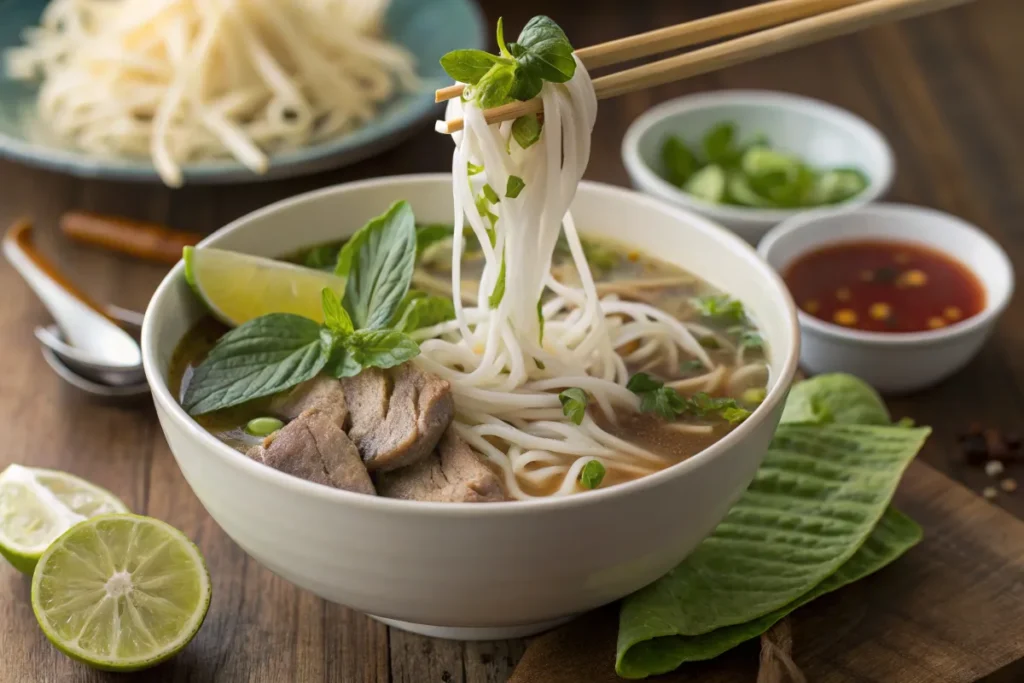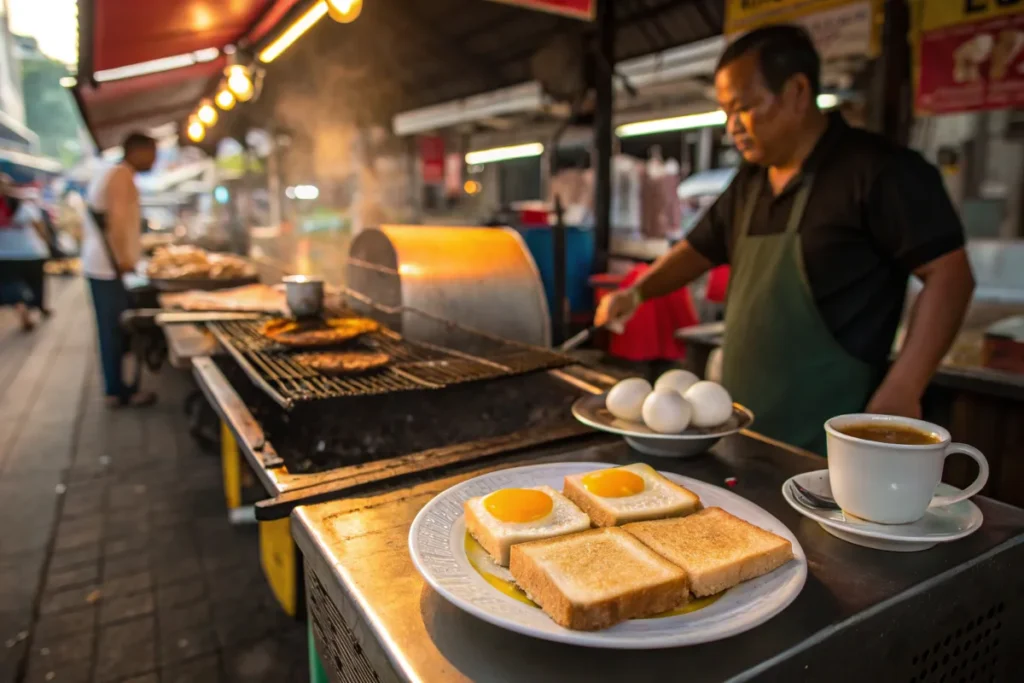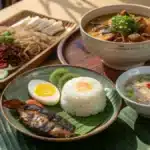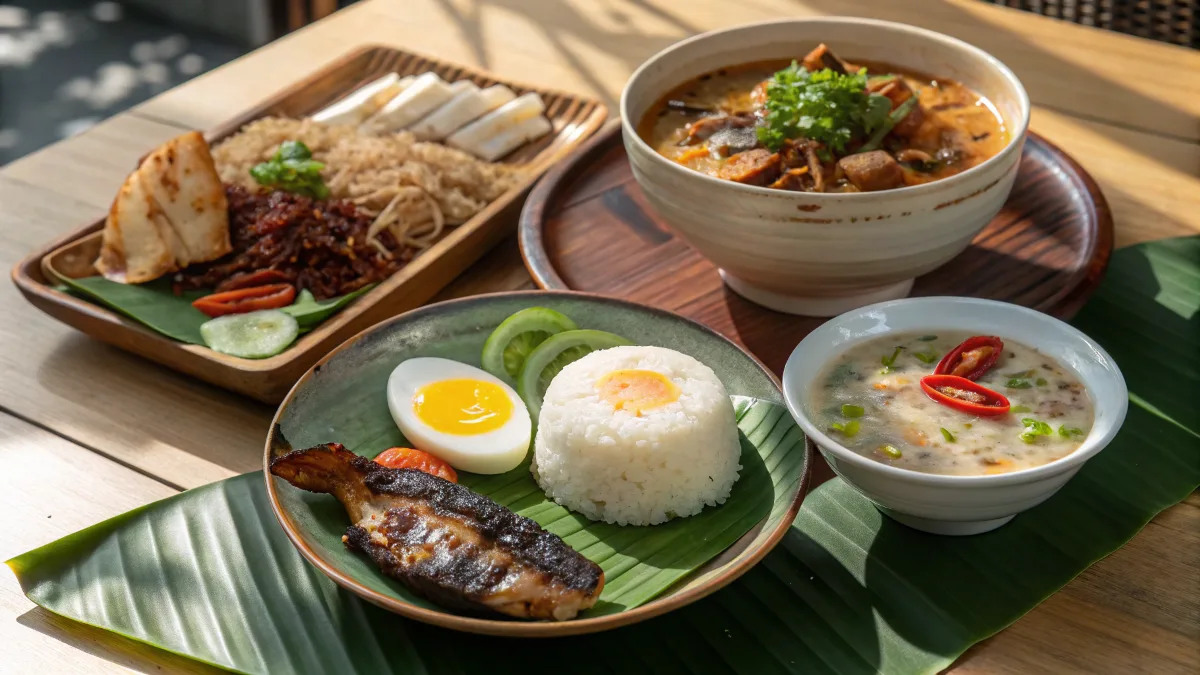Breakfast is often called the most important meal of the day, and in Asia, it’s an experience deeply rooted in tradition, culture, and history. Unlike the typical Western breakfast of toast and cereal, an Asian breakfast is diverse, flavorful, and often quite hearty. Breakfast dishes in Asia are very different. You can find steaming bowls of congee in China. In Malaysia, people enjoy crispy roti canai. Despite these differences, they share some common themes. These themes include balance, nutrition, and comfort.
In this article, we’ll take you on a journey through the fascinating world of Asian breakfast. We’ll explore regional variations, highlight some of the most iconic morning dishes, and even provide tips on recreating these meals at home. By the end, you’ll have a newfound appreciation for the unique flavors that define breakfast in different parts of Asia.
Table of Contents
Introduction to Asian Breakfast Culture
A steaming bowl of congee in China, a fragrant plate of nasi lemak in Malaysia, or a comforting bowl of miso soup in Japan—breakfast in Asia is as varied as the continent itself. Yet, a few key elements unite these diverse morning meals. Let’s take a closer look at what makes an Asian breakfast so special.
What Defines an Asian Breakfast?
Asian breakfasts are typically:
- Savory rather than sweet – Unlike Western breakfasts, which often feature sugary pastries or cereals, Asian morning meals are typically umami-rich, incorporating rice, noodles, soups, and proteins.
- Balanced and nutritious – Many traditional breakfast dishes include a mix of carbohydrates, proteins, and vegetables, providing a well-rounded start to the day.
- Hearty and satisfying – Breakfast is often a full meal rather than a light snack, especially in countries where workdays begin early and demand sustained energy.
Regional Variations and Influences
Asia is vast, and each country has its own take on breakfast. Some key influences include:
- Chinese influence – Many Southeast Asian breakfast dishes, such as kaya toast in Singapore and dim sum in Hong Kong, are rooted in Chinese culinary traditions.
- Indian influence – Countries like Malaysia and Indonesia incorporate Indian-inspired breakfasts, such as roti canai and dosa, due to historical migration.
- Colonial influence – Some Asian countries have adopted Western breakfast elements due to colonial history, like the Filipino pandesal or Vietnam’s famous banh mi op la.
Common Ingredients in Asian Morning Meals
Although breakfast dishes vary, a few staple ingredients are common across the region:
- Rice – The backbone of many Asian breakfasts, from congee in China to nasi lemak in Malaysia.
- Noodles – Found in dishes like pho (Vietnam) and laksa (Singapore/Malaysia).
- Soy-based products – Tofu, soy milk, and fermented products like natto in Japan add protein and depth to many breakfast meals.
- Eggs – Often included in various forms, such as tea eggs in China or tamagoyaki in Japan.
- Fermented foods – Kimchi in Korea and pickled vegetables in China provide probiotics and enhance flavor.
Asian breakfasts are not just about sustenance—they’re a reflection of history, geography, and culture. Whether eaten at a bustling street food stall or prepared lovingly at home, these morning meals set the tone for the rest of the day.
Popular Asian Breakfast Dishes
When it comes to Asian breakfast, variety is the name of the game. Across the continent, breakfast dishes reflect regional ingredients, culinary traditions, and cultural influences. Whether it’s a warm bowl of rice porridge, a crispy stuffed pancake, or a tasty noodle soup, these meals are a great way to start the day.
Chinese Breakfast Staples: Congee, Dim Sum & Jianbing
China’s vast culinary landscape offers a diverse range of breakfast options:
- Congee (Rice Porridge) – A warm and soothing dish, congee is made by slowly cooking rice with water or broth until it reaches a creamy consistency. Toppings vary widely, including pickled vegetables, century eggs, and fried dough sticks (youtiao).
- Dim Sum – Originating from Cantonese cuisine, dim sum includes small, flavorful dishes such as dumplings, steamed buns, and rice noodle rolls, often enjoyed with tea.
- Jianbing (Chinese Crepes) – This street-food favorite is a crispy and savory pancake stuffed with eggs, scallions, crispy wonton, and hoisin or chili sauce. It’s a grab-and-go breakfast staple in many cities.
Japanese Breakfast: Miso Soup, Rice, and Grilled Fish
Japanese breakfasts emphasize simplicity and nutrition. Some key components include:
- Steamed Rice and Miso Soup – A traditional Japanese breakfast often features plain rice served alongside a bowl of miso soup, packed with tofu, seaweed, and green onions.
- Grilled Fish – Commonly, salmon or mackerel is lightly seasoned and grilled to perfection.
- Tamagoyaki (Japanese Omelet) – This slightly sweet, layered omelet is a protein-rich addition to a balanced meal.
Korean Morning Meals: Kimchi, Rice, and Soups
Korean breakfasts often resemble lunch or dinner in heartiness. Some typical dishes include:
- Kimchi and Rice – A simple yet flavorful start to the day, often accompanied by fried eggs and dried seaweed (gim).
- Doenjang Jjigae (Soybean Paste Stew) – A fermented soybean-based stew filled with tofu, vegetables, and sometimes seafood or beef.
- Korean Porridge (Juk) – A mild and easily digestible rice porridge, often flavored with abalone, pumpkin, or ginseng.
Southeast Asian Favorites: Nasi Lemak, Kaya Toast, and Pho
Southeast Asia’s tropical flavors and spice-laden cuisines make breakfast a treat. Popular dishes include:
- Nasi Lemak (Malaysia) – Coconut rice served with fried anchovies, peanuts, hard-boiled eggs, and spicy sambal chili sauce.
- Kaya Toast (Singapore & Malaysia) – Toasted bread spread with kaya (a coconut and egg jam) and butter, usually paired with soft-boiled eggs and coffee.
- Pho (Vietnam) – A fragrant beef or chicken noodle soup made with a rich broth, fresh herbs, and rice noodles.

South Asian Breakfasts: Parathas, Idli, and Masala Chai
Breakfast in South Asia is full of bold flavors and satisfying textures:
- Parathas (India & Pakistan) – Flaky, buttery flatbreads often stuffed with spiced potatoes, paneer, or minced meat, served with yogurt and pickles.
- Idli & Dosa (India & Sri Lanka) – Idli are steamed rice cakes, while dosa are thin, crispy crepes made from fermented rice and lentil batter. Both are typically eaten with coconut chutney and sambar.
- Masala Chai – A spiced milk tea brewed with black tea leaves, cardamom, cinnamon, ginger, and cloves.
Traditional and Modern Asian Breakfast Trends
Breakfast culture in Asia has evolved significantly over time. While traditional dishes remain popular, modern adaptations cater to changing lifestyles, global influences, and health trends.
How Traditional Asian Breakfasts Are Evolving
Many classic Asian breakfast dishes have been modified to suit contemporary lifestyles. Some notable shifts include:
- Faster cooking methods – Instant congee, pre-packaged dim sum, and microwavable idli make traditional meals more accessible.
- Grab-and-go options – With urbanization, on-the-go breakfasts like banh mi (Vietnamese sandwich) and convenience store onigiri (Japanese rice balls) have become widely available.
- Fusion flavors – Modern cafes experiment with fusion dishes like matcha croissants, kimchi avocado toast, and Thai tea pancakes.
Fusion Dishes and Global Influences
As Asian cuisine gains global popularity, traditional breakfast dishes have been reimagined in creative ways. Examples include:
- Ramen Breakfast Bowls – Inspired by Japan’s famous noodle dish, breakfast ramen incorporates poached eggs, crispy bacon, and fresh vegetables.
- Bubble Tea Pancakes – Taiwanese bubble tea flavors infused into fluffy pancakes with tapioca pearls.
- Korean-Inspired Avocado Toast – A twist on the Western favorite, featuring kimchi, sesame oil, and fried eggs.
The Rise of Healthy and Quick Breakfast Options
With growing health consciousness, many people are looking for nutritious yet convenient morning meals. Some emerging trends include:
- Plant-based alternatives – Dairy-free soy milk lattes, tofu scramble, and vegan dim sum.
- Low-carb and high-protein options – Egg-based breakfasts like Japanese chawanmushi (steamed egg custard) and protein-packed moong dal chilla (Indian lentil pancakes).
- Superfood additions – Chia seeds, matcha, and turmeric-infused breakfast items for added health benefits.
Traditional flavors still hold strong, but innovation keeps Asian breakfast exciting and ever-evolving. Whether you prefer a bowl of comforting congee or a modern take on pho, there’s always something delicious to start your day.
Health Benefits of Asian Breakfast Foods
A well-balanced Asian breakfast isn’t just about flavor—it’s also packed with essential nutrients. Many traditional breakfast dishes offer a mix of carbohydrates, proteins, and healthy fats, providing long-lasting energy for the day ahead. Let’s explore how these meals contribute to a nutritious lifestyle.
Nutritional Aspects of Traditional Asian Breakfasts
Most Asian breakfasts are naturally balanced, often containing:
- Complex Carbohydrates – Rice, noodles, and whole grains provide steady energy and keep you full longer.
- Lean Proteins – Tofu, eggs, fish, and lean meats help build and repair muscles.
- Healthy Fats – Sesame oil, nuts, and avocados add essential fats that promote brain function.
- Fiber & Antioxidants – Vegetables, seaweed, and fermented foods aid digestion and support immunity.
For instance, a Japanese breakfast of miso soup, grilled fish, and rice delivers a wholesome mix of nutrients without excess sugar or processed ingredients. Similarly, a bowl of Vietnamese pho provides a protein-rich start with plenty of herbs and vegetables.
Balanced Breakfasts: Protein, Carbs, and Fiber
Unlike sugary cereals or pastries, many Asian breakfast options focus on sustaining energy throughout the day. Some great examples include:
- Congee with soy-marinated eggs and scallions – High in protein and easy to digest.
- Korean juk (rice porridge) with nuts and sesame oil – A fiber-rich meal that keeps you full longer.
- Indian idli and sambar – Fermented rice cakes served with lentil soup, packed with probiotics and protein.
Fermented Foods and Their Gut Health Benefits
Fermented foods play a significant role in Asian breakfast, offering probiotic benefits that support gut health. Some popular options include:
- Kimchi (Korea) – A spicy, fermented cabbage dish loaded with probiotics.
- Natto (Japan) – Fermented soybeans rich in Vitamin K2, which supports heart and bone health.
- Dosa & Idli (India) – Naturally fermented rice and lentil batter, easy on digestion.
By incorporating these nutrient-dense foods, an Asian breakfast promotes better digestion, sustained energy, and overall well-being.
Cooking Asian Breakfast at Home
Want to enjoy a delicious Asian breakfast without leaving home? With a few key ingredients and simple recipes, you can easily prepare authentic morning meals in your own kitchen.
Essential Ingredients to Stock in Your Kitchen
Before you start cooking, stock up on these must-have ingredients:
- Rice & Rice Flour – Used in congee, rice noodles, and pancakes.
- Soy Sauce & Miso Paste – Essential for flavoring soups, stir-fries, and marinades.
- Tofu & Eggs – Great protein sources for a quick breakfast.
- Fermented Foods – Kimchi, pickled vegetables, and miso add depth and probiotics.
- Herbs & Spices – Ginger, garlic, lemongrass, and chili enhance dishes with bold flavors.
With these staples, you can easily whip up a hearty and nutritious meal.
Quick and Easy Recipes for Busy Mornings
Short on time? Try these simple yet satisfying breakfast ideas:
- Japanese Tamago Kake Gohan – Raw egg mixed with hot rice, soy sauce, and scallions for a quick protein-packed meal.
- Chinese Scallion Pancakes – Crispy, savory pancakes made from flour, water, and green onions.
- Thai Khao Tom (Rice Soup) – A comforting rice porridge simmered with garlic, ginger, and a choice of protein.
- Indian Besan Chilla – A high-protein, chickpea flour pancake flavored with turmeric, cumin, and green chilies.
Step-by-Step Guide to Making a Classic Asian Breakfast
Let’s go through a simple recipe for Vietnamese Egg Banh Mi. This is a tasty breakfast sandwich. It has a crispy baguette and flavorful fillings.
Ingredients:
- 1 Vietnamese baguette
- 2 eggs
- 1 tbsp soy sauce
- ½ cucumber, sliced
- 1 tbsp butter
- 1 tbsp mayonnaise
- Fresh cilantro
Instructions:
- Heat a pan over medium heat and melt the butter.
- Fry the eggs until crispy around the edges. Drizzle with soy sauce.
- Slice the baguette and spread mayonnaise inside.
- Add cucumber slices, fried eggs, and fresh cilantro.
- Serve warm and enjoy a taste of Vietnam at home!
For more delicious breakfast ideas, check out our other recipes.
Regional Spotlight: Breakfast in Southeast Asia
Southeast Asia is home to some of the most flavorful and diverse morning meals. From the fragrant spices of Malaysia to the rich broths of Vietnam, a typical Asian breakfast in this region is vibrant, satisfying, and packed with bold flavors. Let’s explore what makes Southeast Asian breakfasts unique.
Iconic Dishes from Malaysia, Thailand, Vietnam & Indonesia
Each country in Southeast Asia has its own take on breakfast, with rice and noodles often serving as the foundation.
- Malaysia – Nasi Lemak: This national dish features coconut rice, crispy anchovies, roasted peanuts, hard-boiled eggs, and spicy sambal, often wrapped in banana leaves.
- Thailand – Jok (Thai Rice Porridge): A silky, savory rice porridge flavored with garlic, ginger, and soy sauce, topped with minced pork and a soft-boiled egg.
- Vietnam – Pho: A fragrant, herb-filled noodle soup made with beef or chicken broth, served with fresh basil, lime, and chili.
- Indonesia – Bubur Ayam: This Indonesian chicken porridge is thick and creamy, topped with shredded chicken, soy sauce, and fried shallots.
Street Food Culture and Morning Markets
Breakfast in Southeast Asia is often enjoyed on the go, with street vendors offering freshly made dishes from small stalls or food carts. Popular morning street foods include:

- Kaya Toast (Singapore & Malaysia) – A simple yet delightful toast spread with kaya (a coconut and egg jam) and served with soft-boiled eggs and coffee.
- Banana Pancakes (Thailand) – A crispy, thin pancake filled with bananas and drizzled with condensed milk, popular among travelers.
- Sticky Rice with Mango (Thailand & Laos) – A sweet and creamy dish made from glutinous rice, fresh mango, and coconut milk.
From bustling markets to humble street stalls, breakfast in Southeast Asia is a celebration of flavors, textures, and culture.
FAQs
Many people are curious about the variety of Asian breakfast options and how they compare to Western breakfasts. Here are answers to some of the most common questions.
1. What is a typical Asian breakfast?
A typical Asian breakfast is hearty, savory, and often includes rice or noodles. Unlike Western breakfasts that emphasize pastries or cereals, Asian breakfasts focus on well-balanced meals with a mix of carbohydrates, proteins, and vegetables. Popular examples include:
- Congee (China) – Rice porridge with pickled vegetables and century eggs.
- Pho (Vietnam) – A nourishing beef or chicken noodle soup.
- Roti Canai (Malaysia) – Flaky, pan-fried bread served with curry.
2. What is a typical breakfast in Japan?
A traditional Japanese breakfast is simple, balanced, and rich in umami flavors. It usually includes:
- Steamed Rice – The base of many Japanese meals.
- Miso Soup – A light broth made with fermented soybean paste, tofu, and seaweed.
- Grilled Fish – Such as salmon or mackerel, providing healthy fats and protein.
- Tamagoyaki – A slightly sweet, rolled omelet.
Japanese breakfasts emphasize fresh, wholesome ingredients, making them one of the healthiest morning meals.
3. What is the healthiest Chinese breakfast?
Many traditional Chinese breakfasts are naturally healthy, with a balance of protein, fiber, and whole grains. Some of the healthiest choices include:
- Congee with Lean Meat or Tofu – A nutrient-rich rice porridge that’s easy to digest.
- Soybean Milk with Whole Wheat Buns – A dairy-free, protein-packed breakfast.
- Steamed Dumplings – Often filled with vegetables and lean meats, offering a good mix of nutrients.
4. What does Southeast Asia eat for breakfast?
Southeast Asian breakfasts are diverse and packed with local flavors. Common dishes include:
- Nasi Goreng (Indonesia) – Fried rice cooked with shrimp paste, egg, and chili.
- Laksa (Malaysia & Singapore) – A spicy coconut-based noodle soup with seafood or chicken.
- Banh Mi Op La (Vietnam) – A crispy baguette filled with fried eggs, vegetables, and soy sauce.
Southeast Asian breakfasts offer a perfect balance of spice, sweetness, and savory goodness, making them a delicious way to start the day.
Conclusion – The Diversity and Charm of Asian Breakfasts
An Asian breakfast is more than just a meal—it’s a reflection of history, culture, and tradition. Across the continent, breakfast varies widely, from the comforting warmth of Chinese congee to the rich flavors of Southeast Asian nasi lemak. Whether served at home, in a bustling street market, or at a local café, these meals highlight the diversity and culinary creativity of Asia.
Why Asian Breakfast Stands Out
Unlike Western breakfasts that often emphasize sweet flavors and light meals, Asian breakfasts tend to be savory, well-balanced, and hearty. They incorporate:
- Nutrient-rich ingredients – Whole grains, lean proteins, and fresh vegetables are commonly used.
- Fermented and probiotic foods – Miso, kimchi, and soy-based products support digestion and gut health.
- Bold and aromatic flavors – Herbs, spices, and umami-rich broths create complex, satisfying tastes.
Breakfasts around the world tell unique stories. In Japan, people enjoy simple and healthy rice and miso soup. In Vietnam, a popular choice is tasty pho. Each dish reflects local flavors and traditions.
Bringing Asian Breakfast to Your Home
Exploring Asian breakfast at home is easier than ever. Many traditional dishes require only a handful of ingredients and can be adapted to fit modern, busy lifestyles. You can make simple recipes at home. Try Japanese tamagoyaki, Thai rice porridge (khao tom), and Indian besan chilla. These dishes let you enjoy Asian flavors easily.
Whether you prefer a comforting bowl of congee or a crispy banh mi, there’s an Asian breakfast for every palate. By embracing these diverse flavors, you can start your day with a meal that is not only delicious but also nourishing and deeply rooted in culture.

Vietnamese Egg Banh Mi
Ingredients
Method
- Heat a pan over medium heat and melt the butter.
- Fry the eggs until crispy around the edges. Drizzle with soy sauce.
- Slice the baguette and spread mayonnaise inside.
- Add cucumber slices, fried eggs, and fresh cilantro.
- Serve warm and enjoy a taste of Vietnam at home!

